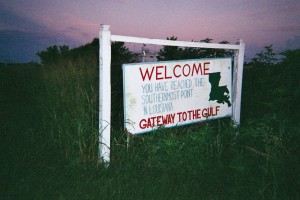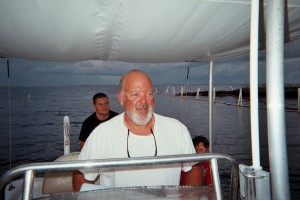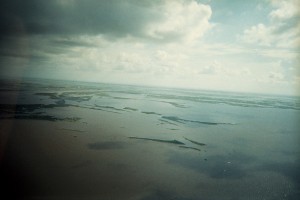Day 7: Castles and Shanties
categories: Cocktail Hour
11 comments
![Into_the_Gulf048[1]](http://billanddavescocktailhour.com/wp-content/uploads/2010/07/Into_the_Gulf04815-300x270.jpg) A couple of summers ago I paid a visit to Kerry Emanuel, an MIT professor of meteorology who was one of the country’s leading authorities on the recent intensification of storms. If you were to read a so-called balanced account of this issue in the newspapers you might come away believing that the scientific jury is still out on whether or not warmer waters lead to more intense storms. In fact, this is a little like saying the jury is still out on evolution versus intelligent design. The real spilt, Emanuel explained to me, was not in the scientific community, but between the scientists and the weather forecasters. He assured me that what common sense suggested was true: warmer waters lead to more violent storms. (Of course this was long before a sheen of oil was added to the warming mix.)
A couple of summers ago I paid a visit to Kerry Emanuel, an MIT professor of meteorology who was one of the country’s leading authorities on the recent intensification of storms. If you were to read a so-called balanced account of this issue in the newspapers you might come away believing that the scientific jury is still out on whether or not warmer waters lead to more intense storms. In fact, this is a little like saying the jury is still out on evolution versus intelligent design. The real spilt, Emanuel explained to me, was not in the scientific community, but between the scientists and the weather forecasters. He assured me that what common sense suggested was true: warmer waters lead to more violent storms. (Of course this was long before a sheen of oil was added to the warming mix.)
This was basically what I expected to hear and I scribbled down what he said in my notebook, playing the diligent coastal detective. But then, right before I was getting ready to thank him and leave, I pointed to the wall and a Hooper painting of a house by the sea. We moved from talking about storms to talking about buildings along the coasts. As it turned out, he had strong opinions on the subject.
“We have a heavily subsidized coastline,” he told me. “Subsidized by a corrupt insurance industry.”
He described how the insurance industry allowed people to build next to the shore without taking the financial risk. How someone in Worcester in central Massachusetts might pay as much as someone living on the shore on Cape Cod.
Then he said something that made my ears perk.
“The natural human ecology of the coastlines tends to be a few castles or mansions built very solidly that will withstand anything nature has to throw. But only a few–everything else is sea shanties. Which the normal person would just go to for a weekend. These shanties or cottages are disposable and people don’t put anything of value in them and don’t insure them. Every now and then they get wiped out and that’s to be expected. It’s the same all over the world….it’s very democratic.”
In other words, throughout most of human history people expected their coastal homes to be occasionally destroyed. I thought, not for the first time, of the difficulties that anyone or anything has in living by the sea. To live by the ocean is to know uncertainty, whether you’re a homeowner or a mollusk or a lobsterman. And it seems that one of the true challenges of living on the coast isn’t to try and control what can’t be controlled, but to learn to live in uncertainties. This, understandably, is not an easy thing to do when an individual or family has invested hundreds of thousands, or more often now, millions of dollars in a property or home. That’s a pretty expensive shanty.
* * *
I have seen my share of both castles and shanties over the last couple of weeks. In Gulf Shores, Alabama, I drove along a stretch of many-storied hotels that stood right on the beach, as if taunting the next hurricane. This was the day before a local event that rated second only to the spill itself in importance, the Jimmy Buffet concert on the beach, and by sheer coincidence I happened to be wearing my Tie-Die shirt and floppy birding hat and so was misidentified by the local amateur ornithologists as a Parrothead. The row of hotels looked just like Emanuel’s castles in the mist, and I said the names out loud as I drove by: The Shoalwater, Windward Pointe (with that fancy final “e”), Pelican Pointe (again the e), The Sands (of course), Blue Water (not anymore), and Summer House(for a giant.) After I passed the last one, I pulled a U-y, and decided to spend the night in the smallest of the giants, a Holiday Inn that was tucked beside them like a little brother. The next morning I took a walk along the shore at dawn, noting how similar the tracks of an ATV are to those of a great blue heron, both looking like peace signs without the enclosing circle, and in fact at some points the huge heron prints were superimposed on the tracks of the ATV. I also thought about the sheer arrogance of building these monstrosities right on the shore, of essentially drawing a line in the sand and daring the ocean to cross. Maybe they would stand—they were castles after all—but at the very least a good storm would destroy the beach that they stood on, paring the sand back to their very foundations. Which means that quite possibly future customers would only be able to check in by rowboat.
I’ve already mentioned another set of wannabe castles, the homes on Dauphin Island, but time and time again, despite their proud and boyish insistence on their own permanence, they have revealed themselves as shanties, periodically plopping off into the ocean. A scientist who shall go unnamed recently wrote me to say that with any luck Bonnie, due to hit these parts on Sunday, will un-do the months of illegal sand redistribution.
Though it now looks like Bonnie is losing steam, one decent storm will wipe out all those months of sneakily carting sand from the islands back to its front, and the residents will find that the laws of nature aren’t as easy to bend as the laws of man. But if one of the themes of my trip has been the impermanence of life by the shore, then all the rest was just warm up for what I have seen in Southeastern Louisiana. Here you have a real sense of the land as fragile, low, and temporary, with a corresponding sense that all of the buildings, however sturdy, are at heart shanties. One misconception people have, one misconception I had until the last couple of weeks, is that New Orleans is in the very south of the state, sitting right on the Gulf. In fact it’s almost a two hour drive south from the city to the town of Buras, where I’m staying, and another half hour to the appropriately-named Venice and beyond. The land down here is a tentative strip, a couple hundred yards wide,  a bowl between a levy that holds back the Mississippi, and another hump of land where the Gulf lies. Unlike the deluded souls on Dauphin islands, the residents here are fully aware of the tentative and impermanent nature of their homes. When Katrina hit, some of these places were twenty feet underwater, and Ryan Lambert, my host at the Cajun Fishing Adventures lodge, pointed up toward the rafters, above the mounted animal heads, where he, despite re-building the rest of the place with new materials, had kept the boards that showed where the water had reached.
a bowl between a levy that holds back the Mississippi, and another hump of land where the Gulf lies. Unlike the deluded souls on Dauphin islands, the residents here are fully aware of the tentative and impermanent nature of their homes. When Katrina hit, some of these places were twenty feet underwater, and Ryan Lambert, my host at the Cajun Fishing Adventures lodge, pointed up toward the rafters, above the mounted animal heads, where he, despite re-building the rest of the place with new materials, had kept the boards that showed where the water had reached.
By my second night in the lodge, I’d grown cynical enough about the political landscape, having encountered scientists and fishermen who had signed confidentially agreements with BP, to sigh and say: “Everyone down here’s got their hand in the till. No one’s above it.”
“I’m above it,” Ryan said curtly, and he was, having his nearly empty lodge at peak season to prove it. “I’d rather meet interesting people than whore myself out,” he said. He didn’t take BP money for use of his boat and lodge, which was vacant except for me, the film crew of the Jean-Michel Cousteau, and the delightful
Lupe, who cooked amazing meals and ran the house. My wife was very impressed when I told her I had met the film crew, and I found myself saying the word “Cousteau,” in a name-droppy kind of way, over and over, but far from being intimidating, the group, led by the outgoing (and highly organized) Holly, were unfailingly generous. They invited me along for anything from a helicopter ride to a trip to the bird hospital (where I got a press badge by posing as Key Grip), and their general vibe reminded me of the ultimate Frisbee teams I played on when I was younger. The ride in the helicopter gave me a sense of just how far and wide the marsh spread, as well as how much had been submerged. People down here love to tell you that they lose about a football field of marsh every half hour (how many football fields/how much time varies depending on who you talk to) but you can’t imagine that this sort of loss is possible
until you see just how vast an area we are talking about. It is here the oil is striking, darkening the fringes of this immensely green and vital landscape like something dark and necrotic.
The day before the helicopter ride, I had taken a boat ride with a local charter fishermen named Sal, another man who had refused to take the oil money, and we rode out to the same islands I’d soon see from above, out to Bataria Bay, noting that some of the water we were boating through still showed up as land on the dated GPS maps. “Firm ground is not available ground,” wrote the poet A.R. Ammons. He was speaking specifically of beach grass, which has trouble finding purchase in the shifting sand, but he might have been speaking about this threatened land. Around here if you stand in a place long enough it might turn from land to water.
Sal pointed out the air plans that had been ripping up the marsh as they flew across the top of it so they could get to places normal boats could not. And why did they need to get to these places? To lay boom to save and protect the marsh. This is one of the consistent ironies you notice down here. It began as a little boy mess—sure we can do it and nothing will go wrong–but once it happened it became an emergency that, according to the little boys, only the little boys can fix. And so you have Blackhawk helicopters carrying sandbags for miles over to the threatened islands, burning thousands of gallons of gas in the process, and everywhere you look you have ships, cars, trucks, planes, and copters charging every which way to protect us from oil.
 On the way out into the bay I saw my first oiled pelican, flapping heavily in front of our boat, and then we reached the marsh edge where the oil first struck.
On the way out into the bay I saw my first oiled pelican, flapping heavily in front of our boat, and then we reached the marsh edge where the oil first struck.
“Erosion is killing us,” said Sal, pointing at the black fringe. “And when the oil hit we got about five years of erosion in one night.”
The signs of defense looked feeble, a white absorbent boom known locally as “tampon boom,” and, the newest brainstorm, actually pom-poms—really–that had been spread over one marsh island, apparently with the hope that the many cotton tentacles would absorb better than a single-limbed boom. When the oil first came in it was the viscosity of peanut butter, but now, while it is still possible to see its effects—the land actually looks burnt—we see no oil. Sal thinks it’s due to the dispersants. “They must have increased the nightly dosage,” he said, shaking his head. “We won’t know the real effects of this for years.”
It was beautiful out, a blazing sunset despite brewing storms and Sal said this was his favorite time to be out on the water. But we headed back in when he saw a water spout to the east over the water, and the clouds on both sides of us darkened. “Are there two different storm clusters?” I asked. “Actually about five,” he said, pointing down at the GPS. “And that one’s chasing our ass.” Though we did our best to outrun the one behind us and skirt the others, the skies opened when we were about half way back.
Through the rain I looked out at the dilapidated fish camps, old marsh shacks that lined the canal about a mile out from the marina. They stood out here on the front lines and had no illusions that they were castles. In fact permeable might be a good word for them, built as they were on a watery foundation, and looking unabashedly ramshackle, pieces of plywood nailed here, a screen door thrown up here, rickety docks jutting out like the tray on a toddler’s highchair. Humility, it seemed to me, was their strength and I decided then and there that I would find a way to spend the night out in one of them.
My night in the shack is a post for another day, but I will add one detail that speaks to the strangeness of my stay in Buras. My hosts in the shack, a couple of nights later, were a 16 year old named Anthony and his uncle, and when I got up at my usual godforsaken writing hour, a little before four, they slept on in the back bunkroom. There was enough of a porch light for me to scribble down notes about the day before, but the canal was dark and even the birds, except for the occasional croaking of a heron, were quiet. I’d been up and writing for about an hour when I heard the puttering of a boat, but I kept my head down in my book, ignoring it. At least until I heard a voice come out of the darkness.
“Morning, David,” the voice said.
Until that second I had felt impossibly remote and removed from the world, and wouldn’t have been more surprised if someone had said good morning to me while camping in Antarctica. But when I got up and walked down to the edge of the dock and the pontoon boat clarified itself in the light and I recognized Holly, who had said good morning, and the rest of the Cousteau crew, heading out for a day of looking for oiled birds.




Perhaps the “pull”in yer u-turn is something you absorbed from the Southern speech you have become immersed in-down here.There is a move sometimes called the “redneck reversal”,a moonshiner move which involves cutting the wheel hard at speed while pulling up hard on the e-brake.Done properly you find yourself facing the way you came with smoke rising from your locked up rear tires and the volume of the smoke and the sound increase as you let go the e-brake and give it the gas to get headed back the way you came.I don’t recall who spoke the praises of the exhilaration of being shot at and not hit but it applies to this move;it requires a rear wheel drive car,smooth or gravel road and a low center of gravity.Keep pulling and banging out these stories as there is much in this culture and land that could use reversal and though the sounds and smells of it involve fear exhilaration is possible.
I always knew those docks reminded me of something,thanks for pinning them to the high chairs.
“Through the rain I looked out at the dilapidated fish camps, old marsh shacks that lined the canal about a mile out from the marina. They stood out here on the front lines and had no illusions that they were castles. In fact permeable might be a good word for them, built as they were on a watery foundation, and looking unabashedly ramshackle, pieces of plywood nailed here, a screen door thrown up here, rickety docks jutting out like the tray on a toddler’s highchair. Humility, it seemed to me, was their strength and I decided then and there that I would find a way to spend the night out in one of them. “Nice image ,and appreciation of place;impermanence accepted gracefully instead of impertinence garishly displayed .
I’m reminded of a certain house on Martha’s Vineyard, one we watched year after year getting closer to the edge of the cliffs at Windy Gates, quite a beautiful place, of course. Even our castles are precarious, even the tallest buildings in our cities, even the planet, when you think about it, even our sun… all mortal, all temporary, through differing quantities of time… All shanties, yes, I like that image, shanties built on the edge of forever…
like… “The Restaurant at the End of the Universe” (Douglas Adams)
Ur from massachusetts; you BANG a U-ey, you don’t PULL a U-ey. ever.
leroi you better watch out–dave will bang u-ey on yr head!
I stand corrected. As a Worcester boy, I should have banged when I pulled.
Don’t give in so easily, Dave, regardless of where you think you’re from- we never BANGED u-ey’s until the nineties, MAYBE late eighties. Prior to that, prior to traction control, prior to cell phones, prior to organic breakfast ceral, prior to right turn on red, prior to a non-Carl Yastrzemski Red Sox team gaining popular favor – we always PULLED u-ey’s. It was all we knew. You’re merely showing your age.
Rich, colorful, savory story-telling – I feel as if I’m there with you, looking over your shoulder.
Another Winner! Jorge.
Always!